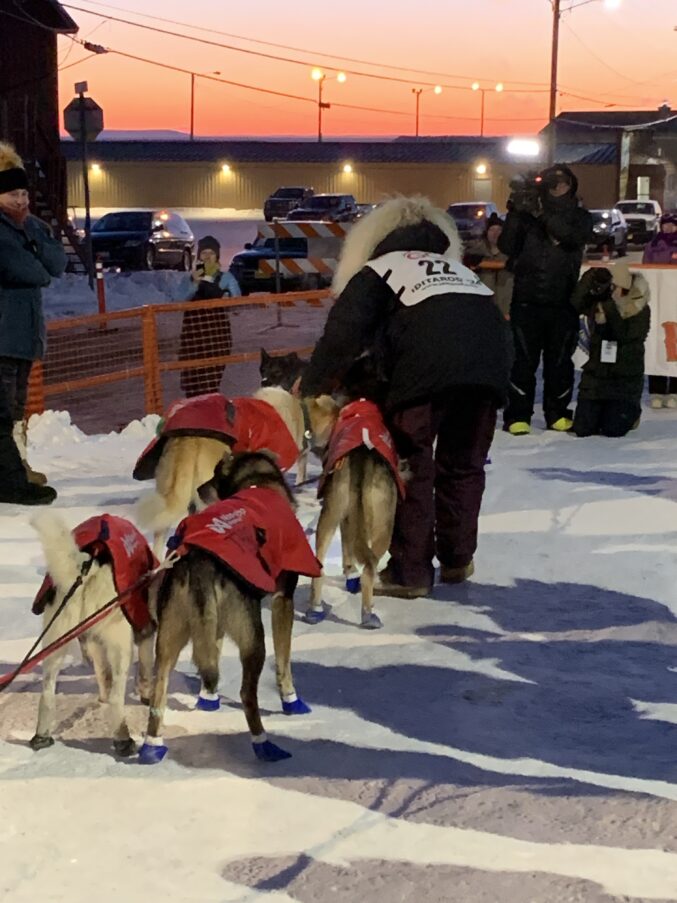The Iditarod is an amazing role model for building relationships. It’s one of the few cultures I’ve been in where friendships form instantly, dogs melt your heart on an hourly basis, and the wide open landscapes of ice, snow, and mountains take your breath away and make you want to linger for a day or a year. Forming a relationship with the Iditarod itself is easy, and for many people, lasts a lifetime.
I was privileged and so excited to be in the chute when Josi Thyr, the first rookie musher, finished her Iditarod. Her handlers, friends, family, and mentors Jessie Royer and Aaron Burmeister were there also. Josi got her first husky as a child and then gradually acquired more dogs. It was then her Iditarod dream formed. For twenty years, Josi built relationships with her dogs and learned from experienced mushers. She is an amazing example of caring, and she inspires other people to care about her. I first met Josi at the IditaRider meeting, and she was gracious and sweet. Then during the ride she answered all my questions and told me about her dogs. At the finish line, she saw me, and gave me a big hug. I am honored to know her.

Josi Thyr finishes her first Iditarod! Photo: K. Newmyer
As teachers we talk a lot about building relationships with students. It’s been studied over and over, that students have a hard time learning from someone they don’t like or feel comfortable with. On the first day of school, we’re challenged to learn students’ names. If we have multiple classes, it’s a challenge just to learn the names in a week. My 16-year-old is great at making new friends, but when I ask what the new friend’s name is, I get a blank stare. Then I have to tease, “the first rule of friendship is knowing your friend’s name!”
It’s not a coincidence that that story came up. The first thing I always want to know about is what are the dog’s names. Knowing the dog’s names gives you something to hold onto and remember; a personality to interact with. Josi told me about her dogs, Lloyd, Spears, Seabiscuit, Griz, Goose, Royal, Ferdinand, Grit, Kodiak, Rip, Boomer, Valor, Admiral, Sunday, Tide, and Ruler. They are all amazing dogs, special enough to make Josi’s Iditarod team! The next thing I want to know about the dogs is if they have any brothers or sisters, or other doggy relatives on the team. Josi’s team has quite a few dogs from the “horse litter,” where all the dogs in the litter are named after racehorses. So sweet!

Josi gives pats to her dogs at the finish line. Photo: K. Newmyer
What kinds of name games can you do in your class to build relationships with students? One activity I like to do is have students introduce everyone in the room—but with a twist. The first person introduces themselves, the second person introduces the first person and then themselves, the third person introduces the first and second person and then themselves, and so on. This one is incredibly fun, but also a challenge for the last person—that’s you, the teacher! Another great relationship-building activity is to give each student a group of facts to find out about their new classmate, then let them work in randomly assigned partners to learn and find out about each other. Then have a showcase of introductions. You don’t have to do the introductions all at once, you can do a few at a time throughout the day.
I’ve often thought it would be incredibly fun to make Iditarod dog trading cards. Students can choose a favorite musher, learn the names of some of their dogs, and then create dog cards to share and trade. For example, Josi’s dog Goose was hiding under the truck at vet checks. Students can create a card featuring a drawing of Goose, his name, the name of Josi’s kennel, There and Back Again Sled Dogs (did anyone else grab The Hobbit reference?) and a bit about Goose’s personality.

Josi Thyr’s Goose. Photo: K. Newmyer
As students create their Iditarod dog trading cards, you can do all kinds of things to build a shared purpose and relationships among students. Students can get together in groups to build a fantasy dog team. They could share their card with another student or with the class. I encourage you, the teacher to participate and model these activities so students feel that you are part of their team, too. This is exactly what the mushers say—they are just part of the team but happen to have two legs instead of four.
Josi demonstrates care for her dogs as a parent, above and beyond her own needs. The first thing Josi did after coming into the finish line, before the mandatory gear check, was walk up and down the line, giving love to each of her dogs, talking to each one and speaking to them by name. These are dogs that helped Josi fulfil a twenty-year dream. How she got there was building a great relationship with her dogs, one name at a time.

Josi Thyr gives love to her dog. Photo: K. Newmyer
What are the ways that you get students started on building great relationships for a great school year? Email me at emailtheteacher@iditarod.com.


